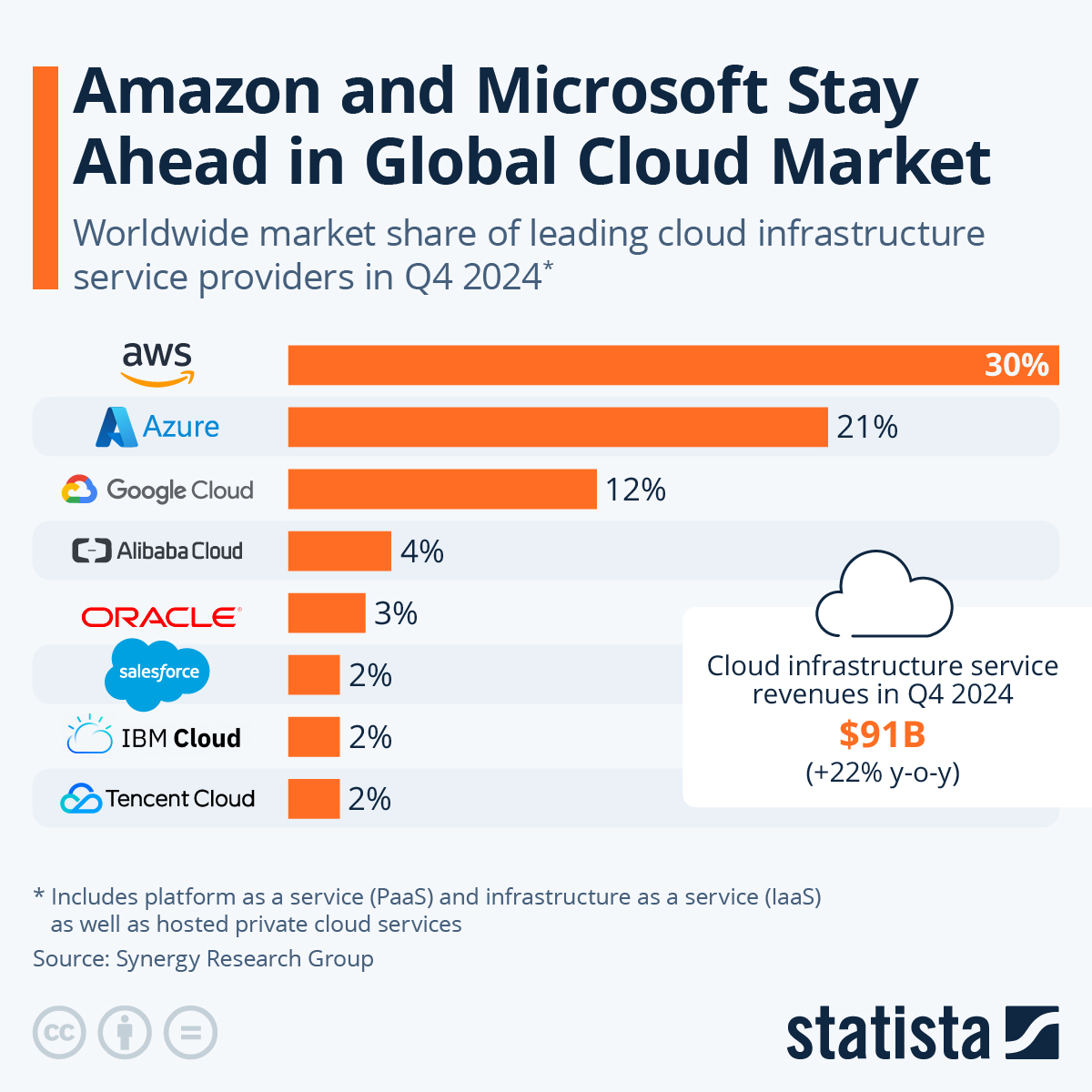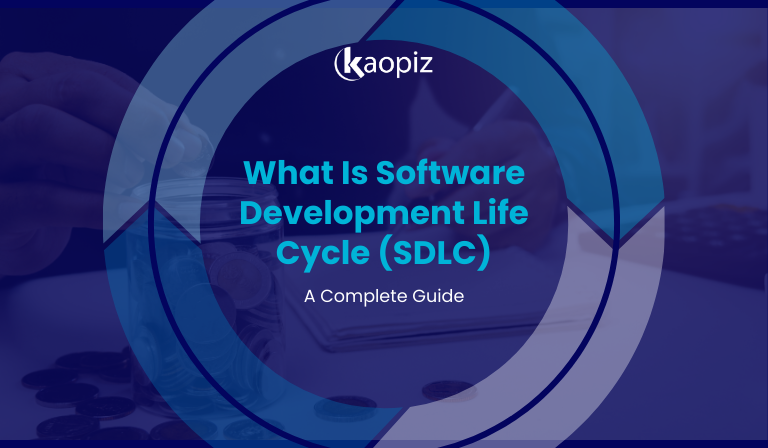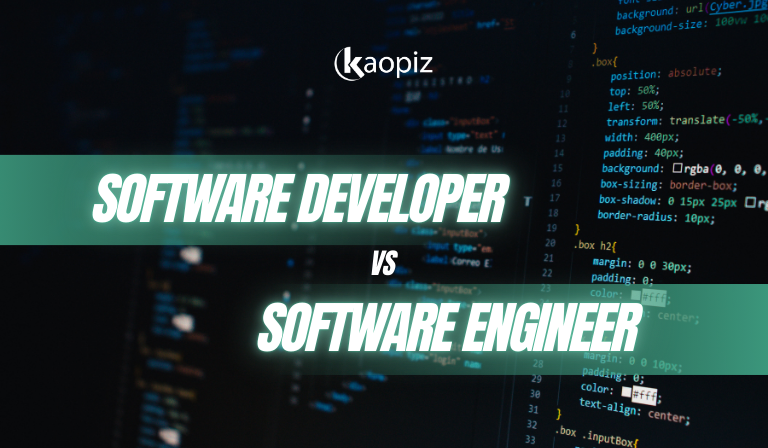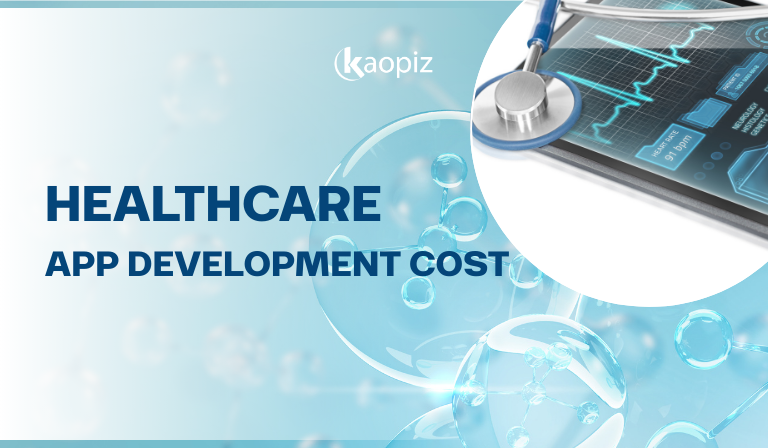AWS vs Azure vs Google Cloud: A 2025 Cloud Comparison Guide
As we move deeper into 2025, cloud computing continues to be a cornerstone of digital transformation across industries. Businesses of all sizes are accelerating their shift to the cloud—seeking greater scalability, agility, and innovation. But with multiple providers offering robust solutions, one question remains at the forefront: Which cloud platform is right for you—AWS vs Azure vs Google Cloud?
This blog provides a comprehensive comparison of the three cloud providers. We break down the key differences, evaluate pricing, performance, ease of use, and highlight emerging capabilities in AI, DevOps, and hybrid cloud.
Table of Contents
- Market Share and Global Reach
- Overview of AWS, Azure, and Google Cloud
- Microsoft Azure vs Google Cloud vs AWS: Key Differences
- AWS vs Azure vs Google Cloud: Which One is Best for You?
- Why Choose Kaopiz as Your Cloud Development Partner
- Conclusion
- FAQs
Market Share and Global Reach
When comparing Amazon Web Services vs Google Cloud vs Azure, understanding each platform’s market share and infrastructure footprint helps clarify their global influence and enterprise reach.
Having established itself early as a pioneer in cloud infrastructure, Amazon Web Services (AWS) continues to lead the global market. According to Synergy Research Group, AWS accounted for 30% of worldwide cloud infrastructure spending in Q4 2024, ahead of Microsoft Azure at 21% and Google Cloud at 12%.
Together, these “Big Three” cloud providers control over 60% of the global cloud market, leaving other vendors to compete for the remaining share in low single digits.

Each provider also differs in its global infrastructure footprint, impacting latency, compliance, and service availability.
Key takeaway:
| Cloud Provider | Market Share | Global Regions | Infrastructure Strengths |
|---|---|---|---|
| AWS | 30% | 30+ | Global scale, service maturity, deep ecosystem |
| Azure | 21% | 60+ | Enterprise-grade integrations, regional diversity |
| GCP | 12% | 35+ | AI-first infrastructure, developer-friendly |
Overview of AWS, Azure, and Google Cloud
Before diving into detailed comparisons, it’s important to understand what each cloud platform offers. Here’s a quick overview of AWS vs Azure vs Google Cloud, including their strengths, weaknesses, and typical use cases.
What is AWS?
AWS is the cloud computing platform developed by Amazon, officially launched in 2006. As the pioneer in the public cloud space, AWS remains the global market leader, offering over 200 fully featured services across compute, storage, databases, networking, AI/ML, and more.
Its robust infrastructure and innovation velocity make it a preferred choice for businesses of all sizes, from agile startups to Fortune 500 enterprises.
Pros and Cons of AWS:
| Pros | Cons |
|---|---|
| Market leader with global reliability and scale | Complex pricing structure can lead to unexpected costs |
| Broadest service portfolio (200+ services) | Overlapping services can create confusion |
| Global infrastructure with 30+ regions and 100+ availability zones | Steep learning curve for beginners |
| Strong ecosystem with a vast community and partner network | Support costs can be high for small teams |
Common Use Cases:
Notable Users:
What is Microsoft Azure?
Microsoft Azure is the cloud computing platform launched by Microsoft in 2010. It has rapidly grown into one of the top three public cloud providers, particularly strong in hybrid cloud solutions and enterprise environments.
Azure cloud integrates seamlessly with widely used Microsoft tools like Windows Server, Active Directory, SQL Server, and Microsoft 365, making it an attractive choice for organizations already invested in the Microsoft ecosystem.
With services spanning IaaS, PaaS, AI, analytics, and DevOps, Azure has become a central player in digital transformation across industries such as finance, healthcare, government, and manufacturing.
Pros and Cons of Microsoft Azure:
| Pros | Cons |
|---|---|
| Seamless integration with Microsoft products (Office 365, Active Directory, etc.) | UI and documentation can be less intuitive compared to competitors |
| Strong support for hybrid cloud and on-premises integration | Some services lack the maturity or flexibility of AWS equivalents |
| Extensive global reach with 60+ regions | Pricing can be difficult to estimate for large-scale deployments |
| Enterprise-ready security, compliance, and governance tools | Fewer services tailored specifically for startups and developers |
Common Use Cases:
Notable Users:
What is Google Cloud Platform?
Google Cloud Platform (GCP)—often referred to simply as Google Cloud—is a suite of cloud computing services launched by Google in 2008, originally under the name App Engine. Today, GCP provides a full stack of IaaS, PaaS, and SaaS solutions, designed to help businesses develop, deploy, and scale applications globally.
GCP appeals strongly to data-driven startups, AI-focused companies, and businesses looking for fast, intelligent solutions. Built on the same infrastructure that powers Google Search, YouTube, and Gmail, GCP has grown rapidly and established itself as a leader in data analytics, AI/ML, and cloud-native application development.
Pros and Cons of Google Cloud:
| Pros | Cons |
|---|---|
| Industry-leading AI/ML and data analytics tools (e.g., BigQuery, Vertex AI) | Smaller enterprise market share compared to AWS and Azure |
| Strong support for Kubernetes and open-source technologies | Limited range of traditional enterprise services |
| High-speed private global fiber network for low-latency performance | Fewer global regions than Azure |
| Cost-effective pricing with sustained usage discounts | Enterprise support and documentation are still maturing |
Common Use Cases:
Notable Users:
Microsoft Azure vs Google Cloud vs AWS: Key Differences
Now that you’ve explored each cloud provider individually, let’s compare AWS vs Google Cloud vs Microsoft Azure side by side to highlight their key differences across core services and features.
Service Comparison
When choosing between AWS vs Azure vs Google Cloud, it’s crucial to evaluate how each provider handles the essential components of cloud computing.
Below is a table comparison of their core service offerings across compute, storage, networking, databases, AI/ML, serverless, DevOps, and hybrid cloud capabilities.
| Category | AWS | Microsoft Azure | Google Cloud Platform |
|---|---|---|---|
| Compute | EC2, Lambda | Virtual Machines | Compute Engine |
| Storage | S3, EBS | Blob Storage, Azure Files | Cloud Storage |
| Networking | VPC, Direct Connect, CloudFront CDN | Virtual Network, ExpressRoute, Front Door | VPC, Cloud Interconnect, Cloud CDN on Google’s global fiber |
| Databases | RDS, Aurora, DynamoDB, Redshift | SQL Database, Cosmos DB, Synapse Analytics | Cloud SQL, Firestore, Bigtable, BigQuery |
| AI/ML Services | AWS SageMaker, Rekognition | Azure Cognitive Services | Google AI, TensorFlow |
| Serverless | Lambda, Fargate | Azure Functions, Container Apps | Cloud Functions, Cloud Run |
| DevOps Tools | CodePipeline, CodeBuild, CloudFormation | Azure DevOps, ARM Templates, GitHub Actions (native) | Cloud Build, Artifact Registry, Deployment Manager |
| Hybrid Cloud | Outposts, EKS Anywhere, Local Zones | Azure Arc, Azure Stack | Anthos, GKE Enterprise |
Pricing Models
Pricing is one of the most critical—and often most confusing—factors when comparing Microsoft Azure vs Google Cloud vs AWS. Each provider offers a mix of pay-as-you-go billing, reserved instances, and custom pricing options depending on usage volume and long-term commitments. Here’s how they compare:
AWS Pricing
AWS uses a pay-as-you-go model, where you only pay for what you use, along with several cost-saving options:
It offers the most flexible and scalable pricing structure, but its complexity often makes accurate cost forecasting and management challenging.
Microsoft Azure Pricing
Microsoft Azure also follows a pay-as-you-go pricing model and provides several flexible cost-saving options tailored to enterprise users:
Azure provides enterprise-friendly pricing and licensing flexibility, though estimating total costs can be complex due to its layered service model.
Google Cloud Pricing
Google Cloud follows a pay-as-you-go model with several cost-saving options:
GCP delivers a transparent and developer-friendly pricing model, though it may lack the deep enterprise-focused discount programs available with AWS and Azure.
Comparative Pricing Table: AWS vs Azure vs Google Cloud
| Feature | AWS | Microsoft Azure | Google Cloud |
|---|---|---|---|
| Spot/Pricing Discounts | Spot Instances (up to 90% off on-demand prices) | Spot Virtual Machines (discounted spare capacity) | Preemptible VMs (short-lived, discounted) |
| Sustained Discounts | Not available | Not available | Automatic discounts up to 30% for consistent usage |
| Reserved Commitments | Reserved Instances (1 or 3 years) | Reserved VMs (1 or 3 years) | Committed Use Contracts (1 or 3 years, up to 57% savings) |
| Hybrid Discounts | Not available | Azure Hybrid Benefit (for Windows & SQL Server licenses) | Not available |
| Free Tier | 12-month free access + always-free services | 12-month free access + 65+ always-free services | $300 credit for new users + always-free services |
| Pricing Calculator | Instance-level calculator | Unified calculator across services | Detailed calculator with cost tools and TCO modeling |
Ease of Use and Learning Curve
AWS offers powerful capabilities but has a steeper learning curve, especially for beginners. The interface is dense, and service names can be overwhelming. However, it provides comprehensive documentation and training through AWS Skill Builder.
Azure is more user-friendly, particularly for teams already using Microsoft products. Its portal is intuitive, and integration with tools like Active Directory and Visual Studio makes onboarding easier. Microsoft Learn offers structured learning paths.
GCP is known for its clean, simple UI and developer-friendly experience. It’s easier for new users to navigate and offers hands-on training through Qwiklabs and Google Cloud Skills Boost.
Here is a quick comparison of Google Cloud vs AWS vs Azure:
| Aspect | AWS | Azure | Google Cloud |
|---|---|---|---|
| Ease of Use | Complex for newbies | Familiar for MS users | Simple and intuitive |
| Learning Curve | Steep | Moderate | Easiest to get started |
| Training | AWS Skill Builder | Microsoft Learn | Google Skills Boost |
Security and Compliance
All three cloud providers offer strong security frameworks, built-in encryption, and extensive compliance certifications. Here’s how they compare:
AWS
Azure
Google Cloud
Let’s look at a security and compliance comparison table:
| Feature | AWS | Azure | Google Cloud |
|---|---|---|---|
| IAM | AWS IAM | Entra ID | Cloud IAM |
| DDoS Protection | AWS Shield | Azure DDoS Protection | Cloud Armor |
| Threat Detection | GuardDuty | Defender for Cloud | Security Command Center |
| Encryption | KMS + default | Key Vault + default | Cloud KMS + default |
| Certifications | 143+ | 100+ | ISO, HIPAA, GDPR |
| Multi-Cloud Security | Security Hub | Azure Arc | Anthos |
Support and Ecosystem
Microsoft Azure vs AWS vs Google Cloud offers robust support plans, rich documentation, and active developer communities to help users build, manage, and scale their cloud environments.
AWS
Azure
Google Cloud
Here is a quick comparison between Amazon AWS vs Azure vs Google Cloud:
| Feature | AWS | Azure | Google Cloud |
|---|---|---|---|
| Support Plans | Developer, Business, Enterprise | Developer, Standard, Enterprise | Standard, Enhanced, Premium |
| Documentation | Extensive + hands-on tutorials | Rich docs + best practices | Docs + Active Assist recommendations |
| Community & Events | AWS Community, Hackdays | MSDN, Tech Community | Cloud Community, technical events |
| Integration Support | Strong 3rd-party ecosystem | Seamless MS integration | Integration Connectors |
| 24/7 Support | ✅ (with premium plans) | ✅ (Standard & above) | ✅ (Enhanced & Premium plans) |
AWS vs Azure vs Google Cloud: Which One is Best for You?
Choosing the right cloud provider depends on your business goals, technical needs, and existing infrastructure. While all three offer powerful, secure, and scalable solutions, each platform shines in different areas.
Why Choose Kaopiz as Your Cloud Development Partner
Selecting the right cloud provider is only the first step—implementing, optimizing, and scaling your cloud solution requires an experienced and trusted partner. That’s where Kaopiz comes in.
As an Advanced Tier AWS Partner, with expertise across Microsoft Azure and Google Cloud, Kaopiz provides cloud services that help businesses navigate the complexities of transformation with confidence. Whether you’re migrating from on-premises, building new cloud-native applications, or optimizing a multi-cloud environment, our team ensures seamless execution and measurable results.

Here’s what sets Kaopiz apart:
With 500+ projects delivered globally, Kaopiz is trusted by enterprises, tech companies, and startups alike to turn cloud strategies into business outcomes.
Conclusion
When comparing AWS vs Azure vs Google Cloud, there’s no one-size-fits-all answer. Each platform brings unique strengths—AWS with its maturity and scale, Azure with enterprise integration, and Google Cloud with cutting-edge data and AI capabilities. Your choice should depend on your technical requirements, budget, existing systems, and long-term goals.
No matter which provider you choose, success in the cloud depends on expert implementation, cost control, and continuous optimization. That’s where Kaopiz adds value—guiding businesses through every stage of their cloud journey with tailored strategies, deep technical expertise, and a commitment to results.
Looking to accelerate your cloud strategy? Contact Kaopiz to get started with a trusted partner who understands the cloud inside and out.
FAQs
Can I Use Multiple Cloud Providers at the Same Time?
Yes. This is called a multi-cloud strategy, and it’s becoming increasingly popular for risk mitigation, cost optimization, and leveraging the unique strengths of each provider. Kaopiz can help design and manage integrated multi-cloud environments tailored to your needs.
Can You Help Us Migrate from On-premises to Cloud?
Absolutely. Kaopiz offers end-to-end cloud migration services—including assessment, roadmap planning, data transfer, re-architecture, and validation—ensuring a smooth and secure transition from on-prem infrastructure to AWS, Azure, or Google Cloud.
What Kind of Support and Services Do You Offer After Cloud Deployment?
We provide ongoing cloud support, including monitoring, cost optimization, security audits, system updates, performance tuning, and 24/7 incident response. You can also scale up with our DevOps and cloud engineering teams as your infrastructure evolves.




















